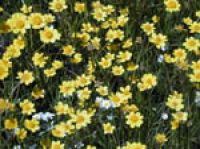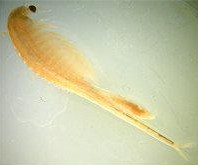
Vernal pools, also called vernal ponds or ephemeral pools, are seasonal pools of water that provide habitat for distinctive plants and animals. They are considered to be a distinctive type of wetland usually devoid of fish, and thus allow the safe development of natal amphibian and insect species unable to withstand competition or predation by fish. Certain tropical fish lineages have however adapted to this habitat specifically.

Arabia Mountain, a part of Arabia Mountain National Heritage Area, is the northern of two peaks in the Davidson-Arabia Mountain Nature Preserve, in DeKalb County, Georgia, United States. A low saddle separates it from Bradley Mountain, several hundred feet to its south. The two form a monadnock. The peak is 955 feet (290 m) above sea level, rising 172 feet (52 m) above Arabia Lake reservoir. Bradley Mountain is closer to the visitor trails than Arabia Mountain and is often misidentified by visitors as Arabia Mountain.

Luronium natans is a species of aquatic plant commonly known as the floating water-plantain. It is the only recognized species in the genus Luronium, native to western and central Europe, from Spain to Britain to Norway east to Ukraine.

Limnanthes vinculans, the Sebastopol meadowfoam, is an endangered species of meadowfoam found only in the Laguna de Santa Rosa in Sonoma County, California, United States and an area slightly to the south in the Americano Creek and Washoe Creek watersheds. The name vinculans derives from the Latin root vinculum, meaning "a bond, a cord." The specific epithet vinculans means linking or bonding, in reference to the sharing of some characters of L. vinculans with L. douglasii (R.Br) and L. bakeri.

Lasthenia conjugens, commonly known as Contra Costa goldfields, is an endangered species of wildflower endemic to a limited range within the San Francisco Bay Area of the state of California, USA. Specifically this rare species occurs in Napa, Santa Barbara, Solano, Contra Costa, Santa Clara, Monterey and Alameda Counties. This annual herb typically flowers from March through June, and its colonies grow in vernal pool habitats at elevations not exceeding 100 meters above sea level. The Jepson Manual notes that the present distribution is limited to the deltaic Sacramento Valley, principally Napa and Solano Counties, but the historic range of L. conjugens is known to be significantly wider. In any case, historically the range has included parts of the North Coast, Sacramento Valley, and San Francisco Bay Area as well as the South Coast. Alternatively and less frequently this taxon has been referred to as Baeria fremontii var. conjugens.

Heteranthera limosa is an annual flowering plant in the water hyacinth family known by the common names ducksalad and blue mudplantain. It grows in shallow water or on mud. It is considered a threatened species in parts of the central United States, and an invasive species weed in California, where it is a nuisance in rice paddies. It is also occasional in Florida waterways.

The conservancy fairy shrimp is an endangered small crustacean in the family Branchinectidae. It ranges in size from about 1.25 centimetres (0.49 in) to 2.5 centimetres (0.98 in) long. This species is endemic to California in the United States.

Branchinecta sandiegonensis is a rare species of crustacean in the family Branchinectidae and the order Anostraca, the fairy shrimp. Commonly known as the San Diego fairy shrimp, it is named after the vernal pools found in San Diego County, California, where this species was originally discovered. It is also a federally listed endangered species of the United States.

Isoetes tegetiformans, commonly known as mat-forming quillwort or mat-forming Merlin's grass, is an aquatic lycophyte endemic to the U.S. state of Georgia. It grows exclusively in shallow, temporary pools on granite outcrops, often with only 2 cm of soil. Only 7 populations are known to exist, and three of these have been destroyed since the plant's discovery in 1976. The remaining populations are threatened with habitat destruction due to quarrying, though the species is protected under the U.S. Endangered Species Act. New leaves quickly sprout after fall and winter rains, but during the dry summer months these typically shrivel.

Isoetes melanospora, commonly known as black-spored quillwort or black-spored Merlin's grass, is a rare and endangered aquatic lycophyte endemic to the U.S. states of Georgia and South Carolina.

Gratiola heterosepala is a species of flowering plant known by the common name Boggs Lake hedgehyssop.
Euphorbia hooveri is a species of euphorb known by the common names Hoover's sandmat and Hoover's spurge. It is endemic to California, where it grows in the rare vernal pools of the Central Valley. Due to the elimination of most of its habitat, it became a federally listed threatened species in 1997.
Isoetes howellii, or Howell's quillwort, is a species of quillwort, a type of lycophyte. It is an aquatic plant native to North America.
Senecio cadiscus is a species of aquatic flowering plant in the aster family, Asteraceae. It is endemic to the Western Cape of South Africa, where it grows in vernal pools. It was at one time classified as Cadiscus aquaticus, the only species in the monotypic genus Cadiscus, but molecular phylogenetic analysis showed that it is nested within Senecio. It is a floating or emergent plant with small narrow leaves and white-rayed flowers. Its populations are small and fragmented, and are declining. The plant is threatened by grazing and trampling by livestock, invasive plants, reclamation of wetlands and eutrophication from fertilizer runoff. The International Union for Conservation of Nature has consequently rated it as "critically endangered".

Orcuttia is a genus of grass in the family Poaceae. Plants grow up to 20 cm (8 in) tall, usually with many stems emerging from the base of the plant, and forming a tuft. The spikelets are several-flowered, with reduced upper florets. The lemma tips have between two and five teeth.

Potamogeton polygonifolius or bog pondweed, is an aquatic plant. It is found in shallow, nutrient-poor, usually acid standing or running water, bogs, fens and occasionally ditches.
Isoetes eludens is an aquatic plant in the genus commonly known as quillwort that is native to the Kamiesberg Mountains in Namaqualand, South Africa. So far it is known to grow only in a single !gau (gnamma), a small temporary pool formed in a hollowed out area of granite rock. It has likely been growing in that region for millions of years, but was only discovered in 2007 and described in 2009. The specific epithet eludens refers to the fact that it eluded discovery, in spite of several searches in recent years in the area for new quillwort species.

Eriocaulon parkeri is a species of flowering plant in the pipewort family known by the common names Parker's pipewort and estuary pipewort. It is native to eastern North America, where its distribution spans the coast from Quebec to North Carolina. It is extirpated from New York and Pennsylvania, however.

Gratiola quartermaniae, commonly known as the limestone hedge-hyssop, is a species of flowering plant in the plantain family. It is native to eastern North America.
Isoetes stephanseniae, the granite quillwort, is a species of quillwort from South Africa, named for A. J. Stephansen, who discovered it in 1927. Of very limited distribution, it is known to survive only as one population in seasonal pools over granite near Stellenbosch, where it is threatened by the encroachment of alien species and eutrophication from the sewage works on whose grounds it grows. Like other quillworts, it bears a tuft of leaves with distinctively sculpted megaspores. It is most similar to Isoetes capensis, the cape quillwort, which occurs in the same province; both hold their leaves at a 45-degree angle, unlike most South African quillworts which have leaves stiffly erect.
















